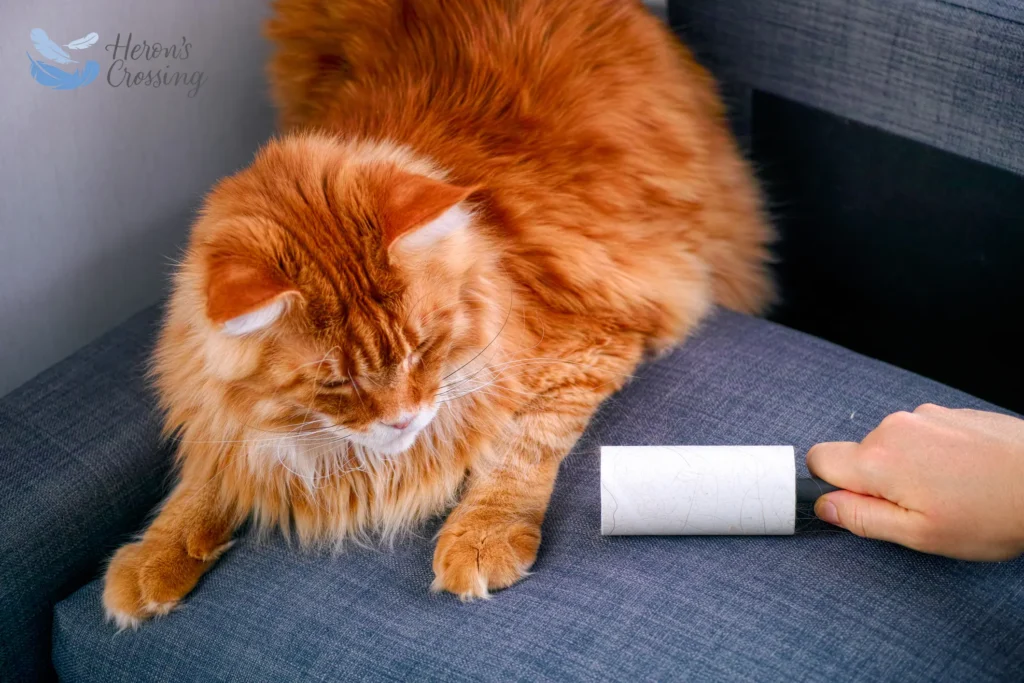If you live with a cat, you can’t help but take a little fur with you wherever you go. It’s a constant battle to keep the house clean. And the number one rule is: don’t wear black, it will show everything. Yet, there are some ways to keep the fur flurries to a minimum.
Start at the source
Brush your little buddy for a few minutes each day to help remove loose fur. Use a boar bristle brush, slicker brush or a grooming glove to stimulate healthy circulation. Offer self-grooming, too, with plastic bristle brushes that attach to table legs or walls.
Gently use a steel comb to pry apart small tangles. But if you have a long-haired cat with matted fur clumps, take your cat to a professional groomer or to your vet. These mats can be painful and dangerous to remove from such delicate skin.
Diet: To help make your cat’s fur healthier, provide plenty of fresh, filtered water and high quality pet food.
Housekeeping
Anything that creates a static charge is going to attract fur. Anything that can break that charge or overpower it can remove it. The other fur attractor is texture. It often becomes entangled in something else, like the carpet, and must be physically extracted.
Cleaning/Dusting: Use lamb’s wool, microfiber and other types of static dusters on most surfaces. A polyester static duster like Swiffer creates a mild attracting charge when wiped over a surface. A static duster is also the best solution for bare floors. But, for electronics, instead of using a static product, use a textured cotton sock or washcloth, compressed air to blow it out, or specially made anti-static cleaners.
HVAC: Run the HVAC fan more often to help remove airbound fur. A standard filter works better than a HEPA style for collecting fur, and it doesn’t put as much strain on the HVAC system. Just change the filter more often and make sure the intake vent stays clean.
Vacuuming: A vacuum cleaner with rollers made to catch pet fur without clogging really makes a difference. Use the bristled attachment for heavy fabrics like cushions, drapes and even winter coats. A cordless hand vac is worth the investment for the convenience, especially for cleaning cars. If you’re going to use a hand-held attachment around small items that could get sucked into the hose, put some netting (produce sometimes comes in a netted bundle) over the hose attachment and secure it with a rubber band. That should catch the fur, not the toy parts.
On the Fly: Remember that grooming glove? Try that or slightly damp rubber dishwashing gloves on upholstery and clothing. Sneakers with grooved or grip soles are great for extracting deeply embedded fur from carpeting, especially on carpeted stairs. Shuffle-dance or hold your sneaker like a brush to loosen and remove deeply entwined fur. Once you get the upholstery, drapes (or car seats) clean, apply some anti-static spray.
Pet Bedding can create a nightmare. Wash pet bedding and blankets at the laundromat if possible, so the fur doesn’t get into your washer and dryer systems. If you do use your home washer, manually clean the drum out with a wet paper towel before washing another load, and then let the bedding air dry to avoid contaminating the dryer. Lots of fur can clog your dryer vent and possibly catch fire. You may have to run a washer hot water rinse cycle with ½ cup of white vinegar or some grease-cutting laundry detergent to get the pet smell and fur oils out.
Regular Laundry: Use dryer sheets to reduce further static cling. There are a variety of ‘so-so’ fur catchers for the washer that work for top load units. FurZapper is a double-duty reusable static cling ’hockey puck’ shaped fur catcher that can be used in top or side load washers and also the dryer, doubling your chances of fur recovery. Some pet parents swear by the use of tennis balls or wet towels to catch fur in the dryer. Success may depend on the type of fabric, or whether the dryer is electric.
Clothing
Brush, Rake, Stick: Try a rubber-bristled brush, the standard Velcro-like lint brush, sticky tape or a slightly damp dishwashing glove. You’ll need to keep a lint brush with you everywhere you go. A small marvel is the handheld lint rake with a dual sided bar, with tiny claws on one side for textured fabrics like wool and boucle, and a rubber strip for sensitive or flat fabrics. You can hang it on a hook inside your closet to keep it handy.
The future of fur removal may be in an electronic brush that uses ultrasonic vibration to shake the fur loose, with an LED light to help find strays. It’s getting good reviews.
Then use anti-static spray on dry clothing to keep from attracting more fur. Keep the closet door closed and clothing safe from circulating air and more fur. You may need two wardrobes, one for home, and one to change into before running out the door. Or try wearing a housecoat over your good clothing.
Although loose cat fur requires a lot of work to manage, we would never give up our pets. They bring us so much love and delight. Perhaps you could just think of that fur on your shoulder as a little token of affection.
Heron’s Crossing provides end-of-life care for pets in the Metro Atlanta area. In-home appointments with compassionate vets are available. If you’d prefer a home-like setting away from your home, our Decatur office is also available by appointment.

